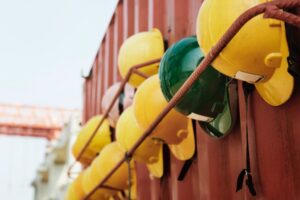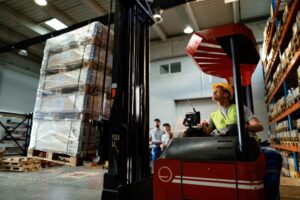Contents
Not certain whether to use an active (RTLS) or passive RFID asset tracking system?
Many companies have heard of real-time locating systems, but may not be certain whether to use an active or passive RFID tracking system. Each type of asset tracking system offers its own benefits. Active systems offer real-time monitoring of assets, while a passive system is useful for tracking item level ownership with minimal hardware needed. Understanding when to use active RTLS is straightforward.
What Is Active RTLS RFID?
This RFID asset tracking system uses a tag containing circuitry, chips, and batteries to track assets. Active RFID tags send out identifying information via radio frequency signals nearly constantly. This information is picked up by fixed RFID readers, the location of each asset is calculated and sent along to Litum’s RTLS asset tracking software to interpret. This allows manufacturers to track assets with RFID tags as they are moving around the floor from dozens of meters away.
What is Passive RTLS RFID?
A passive RFID system consists of two main components: tags and reader. Passive tags rely on the power emitted from the reader to transmit their signal. This power can only travel short distances (up to 10 meters), which limits their range. However, this also makes them less expensive than active tags. Additionally, because passive tags don’t have batteries, they require little to no maintenance.
The downside of passive RFID asset tracking systems is that they have shorter range and lack real-time monitoring capabilities. This means they are not well-suited for tracking high-value items like IT assets that need to be monitored in real-time.
Best Uses of The Active System
Since an active RFID asset tracking system sends out a regular signal, it’s useful for real-time monitoring and tracking of assets. Airports, manufacturing facilities, and many more can use active RFID tags to track employees, assets, tools, and equipment.
Other uses for an active asset management solution include:
- Automated check-in/checkout of vehicles and drivers
- Equipment and asset tracking in real-time
- Assigning equipment to qualified employees, monitoring usage
- Improved monitoring temperature and conditions
- Monitoring traffic & controlling signalization
- Tracking and directing vehicles on a busy lot
Active RFID is well suited for tracking high-value assets or assets that are frequently moved around (such as inventory in a warehouse). Passive RFID is more often used for tracking items that are not moving very much or that do not need to be tracked over long distances (such as library books).
Here’s a more detailed breakdown of how active RTLS RFID can be used in industrial settings:
Asset Tracking
One way to use active RTLS RFID is for asset tracking systems. If you have a lot of equipment or tools that need to be tracked, RFID asset tags can be attached to them. Then, you can use an asset tracking solution to keep track of where they are and who is using them. Using real-time asset data, you can help improve equipment management, prevent asset losses, and make sure that things are getting returned to the right place.
Personnel Tracking
Active RFID systems can also be used to track employees in real time. This information can be used for a variety of purposes, such as understanding employee productivity patterns, optimizing staff schedules, and ensuring compliance with safety regulations. In many cases, Active RFID systems are integrated with existing badge or access control systems to provide a complete picture of employee movements throughout the day.
Temperature Monitoring
Active RFID tags can be used to monitor temperature changes in perishable goods, data centers, warehouses, and other environments where temperature control is critical. By attaching an active tag to a pallet of goods or a piece of equipment, you can receive real-time alerts if the temperature exceeds or falls below a certain threshold. This allows you to take corrective action quickly to prevent damage or deterioration. For example, if a server room becomes too hot, you can be notified immediately so that you can take steps to cool it down and avoid costly downtime.
Environmental Monitoring
In addition to temperature, active RFID tags can also be used to monitor other environmental conditions such as humidity, light exposure, and even vibration. For example, you could use an active tag to monitor the humidity level in a storage room full of electronics. If the humidity gets too high, the tag could trigger an alert so that you can take steps to mitigate the problem before it causes damage to your equipment.
Safety and Security
Active RFID tags can also be used for safety and security applications. For example, you could attach an active tag to a chemical container in order to monitor its location and receive an alert if it’s moved outside of a predefined area. Or you could attach an active tag to a piece of dangerous machinery in order to receive an alert if someone enters the area without authorization. The possibilities are endless!
Why Use Active RFID Asset Tracking RTLS Systems?
Naturally, the uses for an active RFID-based asset tracking system can also be completed by a group of experienced employees. So, why choose an active system that may have a more expensive initial setup?
Small businesses may be interested in RFID asset tracking. But, may not have a good idea of how an RFID-based asset tracking system can help them yet. Here’s why:
Passive RFID tags are simple to use and inexpensive to purchase. However, they are quite limited in their application. They only ‘ping’ and are visible to the RTLS software when they receive a signal from a mobile or fixed RFID reader. Otherwise, they’re invisible. You’ll have to go searching for an item or tool that is misplaced in a large warehouse.
An active asset tracking RFID tag contains a battery and retain their charge for months at a time. This allows you to maintain constant surveillance of assets on the floor with minimal effort needed for recharging tags.
Businesses also cut down on man-hours and time wasted by not having to go searching for lost items or even people. Active tags can also be outfitted with panic buttons so that workers in hazardous environments can signal for help.
To find out more about how Litum can help improve your operations, contact us now.



